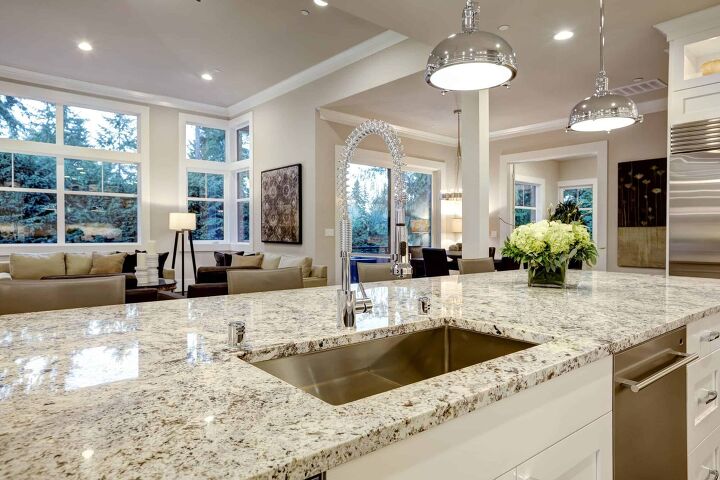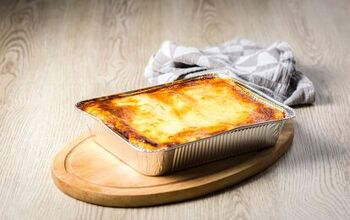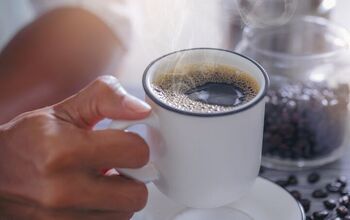Can You Put Hot Pans On Granite? (Find Out Now!)

Kitchens are the centerpiece of many homes, and builder-owners put a lot of time and attention into its design. There are many choices for countertops, such as marble, or quartz, but many builders choose granite for durability and appearance. It is widely known amongst builders and renovators that it is heat resistant, but can you put hot pans on granite?
You can put hot pans on granite briefly without damaging it. While we recommend using a trivet, granite can absorb heat without cracking or warping. Granite has a heat resistance threshold of up to 480 degrees Fahrenheit. However, excessive heat can cause your granite countertop’s seal to weaken, which will expose it to stains and liquid damage.
Granite is quite heat resistant, particularly compared to materials such as laminate. You can get away with momentarily putting a hot pan on granite, but if you continually do it, you can create stains and damage.
Follow along as we get into the nitty-gritty of putting hot pans on granite and how temperature affects the material.
Do You Need Countertop Installation Services?
Get free, zero-commitment quotes from pro contractors near you.

Can Hot Pans Damage Granite?
If you continually put hot pans on granite, it can cause damage because of the abrupt temperature change. Extreme temperature changes are known as thermal shock, and it can damage granite in several ways, such as:
- Burn marks
- Damage the sealant/finish
- Create cracks
- Chipping
Cracks and chipping, for example, can be repaired by applying epoxy and a hardener to the granite countertop. You can also patch the damaged sealant for $16-$25 using a 24-ounce granite sealer, such as Granite Gold sealers.
Granite Heat Resistance
Granite is known to have heat resistance up to 480 degrees Fahrenheit, but it can vary based on the cut and thickness. In fact, granite is believed to handle heat up to 1,000 degrees Fahrenheit, although it is not advisable to test that theory. You may have noticed that your granite countertops don’t take on heat from surrounding appliances, or the sun.
If granite can handle such extreme temperatures, why can’t it handle hot pans? Technically, granite can handle hot pans, but prolonged heat exposure causes more and more damage, and weakens the granite over time. Although brief encounters with hot cookware may not cause any harm, placing a barrier between the surface and a hot pan will greatly reduce the risk of cracks, stains, and the weakening of sealant.
How Does Granite Compare to Other Materials?
Granite is known to be one of the most durable countertop materials on the market, but it still falls behind other alternatives, like soapstone. Many of the materials similar to granite only vary slightly in heat resistance and durability, but it makes a difference.
Quartz Vs. Granite
Quartz can handle hot pans better than granite, but you still risk thermal shock. Similar to granite, if you place a hot pan on a quartz countertop, there may be no immediate damage, especially if it’s just for a brief moment. However, that does not mean that damage will occur, as is the case if there is an abrupt temperature change.
The heat threshold for quartz is 175-185 degrees Fahrenheit, however, quartz cannot burn. Despite having a lower temperature threshold than granite, quartz is less susceptible to thermal shock than granite. Thermal shock plays more of a role in countertop damage than temperature itself for many materials.
Soapstone Vs. Granite
Compared to all other countertop materials, soapstone handles hot pans the best. Soapstone has become quite popular over the years, largely in part due to its heat resistance, and appearance. The main reason for soapstone being so heat resistant is because it experiences temperature changes slowly.
Because soapstone naturally slows down changes in temperature, it effectively eliminates the chances of thermal shock. Without the risk of thermal shock, you do not need to worry about damaging your soapstone countertops by setting a hot pan on it.
Marble Vs. Granite
Marble is extremely susceptible to heat and burn damage from putting hot pans on it. While granite is a dense, compact material, marble is quite brittle and not very heat resistant. Marble has a similar heat threshold, around 480-500 degrees Fahrenheit, but is a much softer materials and not as durable as granite, quartz, or soapstone.
Avoid putting hot pans directly on marble, as there is a high risk of thermal shock, especially if done frequently.
Laminate Vs. Granite
Putting hot pans on laminate is a recipe for disaster. Unlike the previously mentioned materials, putting hot pans on laminate usually causes immediate damage. The main risk of setting a hot pan on a laminate countertop is not thermal shock, that it will burn.
Laminate has a low heat resistance threshold, at roughly 275-300 degrees Fahrenheit. Because of that, you should always have a trivet ready for when a hot pan comes out of the oven.
| Material | Heat Resistance | Suitable For Hot Pans | Cost |
| Granite | 480 degrees Fahrenheit | No | $36-$60 per sq. ft. |
| Quartz | 185 degrees Fahrenheit | Yes (brief encounters) | $55-$75 per sq. ft. |
| Marble | 400 degrees Fahrenheit | No | $40-$100 per sq. ft. |
| Soapstone | 2,000 degrees Fahrenheit | Yes | $70-$120 per sq. ft. |
| Laminate | 275-300 degrees Fahrenheit | No | $10-$20 per sq. ft. |
How to Avoid Granite Heat Damage
Heat damaged caused by hot pans on granite is a hassle and requires attention. The best course of action is to avoid any heat damage at all by taking steps to protect your granite.
- Use hot pads and trivets
- Avoid putting cold objects on the granite before or after a hot pan
- Minimize the amount of time that hot pan is on surface
- Wait until the pan has cooled off before putting it on the counter
- Place a silicone dish on the counter for the pan to sit on
Protecting your hot pans from heat damage is as simple as avoiding leaving hot pans on it too long. Also, anything that you can do to avoid thermal shock, i.e. mixing hot and cold, needs to be done. You may only be placing the hot pan on the granite for a moment, but if the surface is cold, each second can weaken the material and sealant.
What Can Damage Your Granite Countertops?
Besides hot pans, there are several things that can cause damage to your granite countertops and should be avoided. These include:
- Spills: Spills are bad news for almost any surface, but with granite, it directly affects the seal and weakens it. Quickly cleaning up after spills can protect your granite from stains and keep the finish as durable as when it was applied.
- Raw Meat: Although a granite countertop that is well-sealed is designed to keep bacteria from infiltrating into the crevices, you shouldn’t take a chance. The meat won’t directly harm the surface, but the remnants can. Instead, always use a cutting board and then follow up with soap and water.
- Knives: While granite is tough and can typically handle knives, your knives may be the ones to experience damage. Using your granite surface as a cutting board will quickly damage and dull the blades of your knives.
- Acidic Items: Using household items that are acidic on your granite can damage the seal and etch the surface. Both will cause the surface to stain more easily. Some substances you should avoid placing on your granite include vinegar, perfume, nail polish, lotions, citrus fruits, soft drinks, and some soaps. If you aren’t sealing regularly, these items can cause discoloration.
- Excess weight. You should also avoid putting any excess weight on your granite countertops. Since granite is a natural rock, the fissures and striations are very vulnerable to cracking under substantial weight. Both storing too much on the countertops, or even sitting or standing on it, can eventually cause cracking.
- Overfilling Undermount Sink: Overfilling the sink installation in the granite can also cause damage both to the granite, and the plumbing beneath it. Although undermount sinks are attached securely to the bottom of granite countertops, overfilling, or even using the sink as a bath for children, can loosen the mounting.
Although granite is a very tough natural stone material, as a porous (in its unsealed form) surface with “veins,” it’s important that you know the proper care techniques and what should be avoided. That way, you can enjoy the beauty of your granite countertops for many years to come.
Do You Need Countertop Installation Services?
Get free, zero-commitment quotes from pro contractors near you.

Summing it Up
Technically, you can put hot pans on granite, but over time, it will weaken the surface and can cause damage. If the granite is cold and you place a hot pan on it, it can cause thermal shock and immediately weaken the countertop. Granite can withstand up to 480 degrees Fahrenheit, and as such, briefly resting hot pans on granite is typically not going to cause damage.
Keep your granite countertops safe by placing a hot pad or trivet down before putting the hot pan on the counter. If you must put hot pans on your granite countertop, be sure to avoid putting anything cold on the surface until it has cooled down. Otherwise, you run the risk of thermal shock, and ultimately, damaging your granite.
Quartz and sandstone can both handle hot pans better than granite, but granite is still a great, durable choice for countertops.

Nick Durante is a professional writer with a primary focus on home improvement. When he is not writing about home improvement or taking on projects around the house, he likes to read and create art. He is always looking towards the newest trends in home improvement.
More by Nick Durante



























